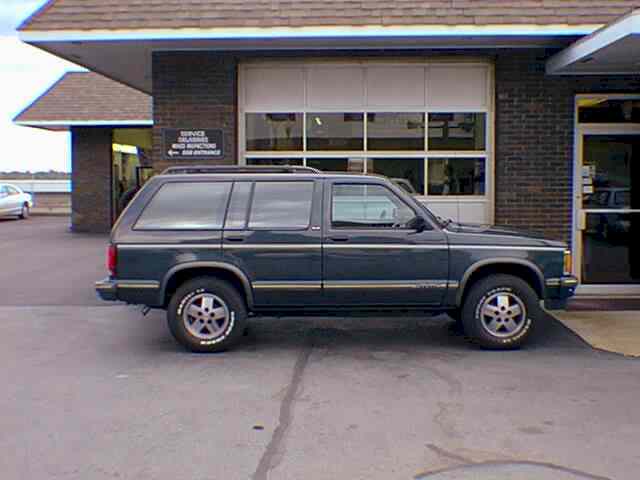
This Jimmy was having a rough day. But we couldn't forget that the customer
was having one too!
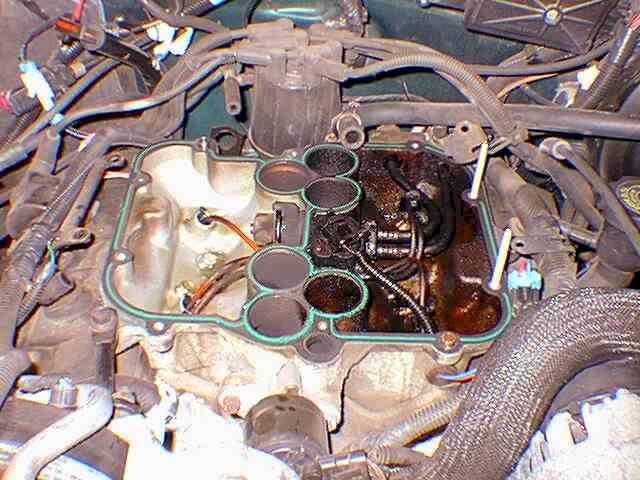
Here is an overhead view of what we found once we removed the upper
intake manifold. Notice how the fuel from the leaking fuel pressure regulator
has washed off the oil deposits that are normally present due to PCV pullover.
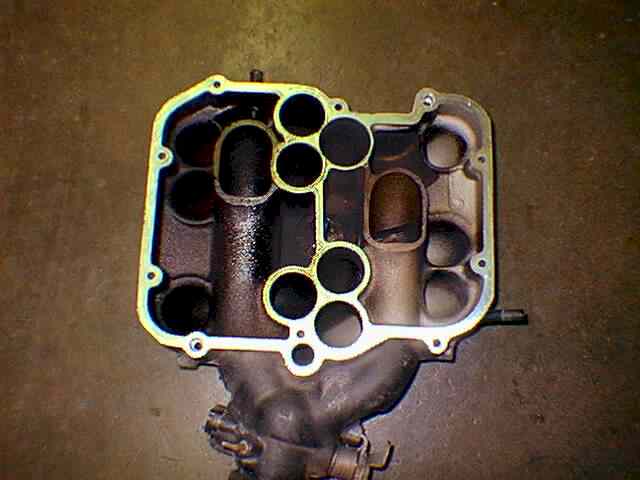
The inside of the upper intake plenum reveals how the fuel leak has also
cleaned one side.
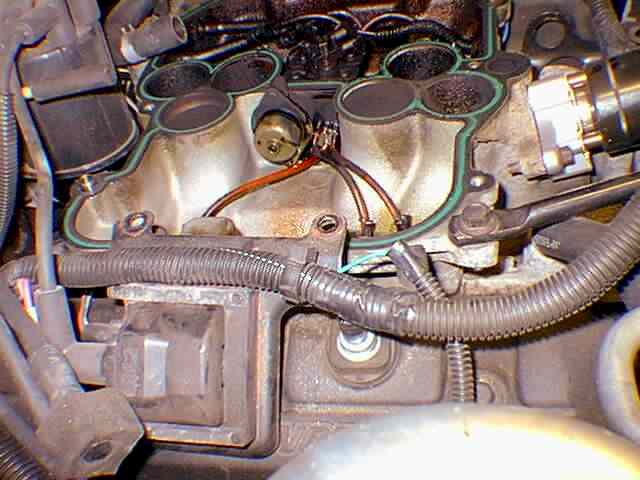
Here is a side view of the fuel pressure regulator. The diaphragm has most
likely ruptured causing raw fuel to leak from its vent hole.
]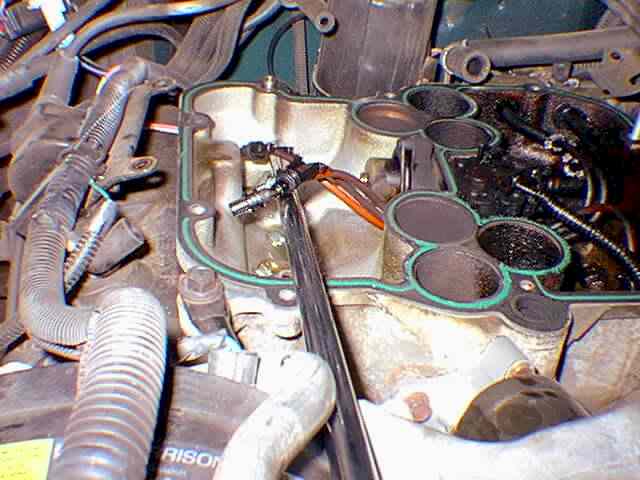
This is a view of one of the six poppet nozzles when it is pulled
out of the intake. Although the nozzles didn't fail on this car, they can
fail in the open position causing the same symptoms of "rich running".
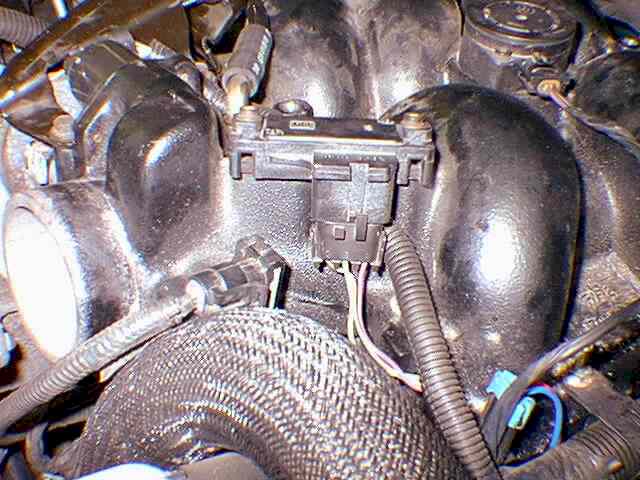
Although we did not have to test it, the Jimmy's MAP sensor is easily
accessible for testing. It would be nice if all the other electronics were
within reach like this.
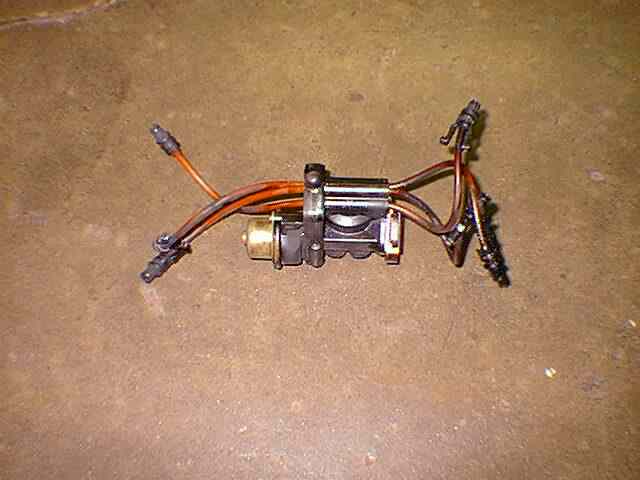
Here we have the fuel injector assembly out on the bench. Unfortunately,
the fuel pressure regulator is not available separately. The new injector
assembly comes as you see it with pressure regulator, hoses and poppet valves.
Advise your customer to sit down first before you give them the price.
|
VEHICLE: 1994 GMC Jimmy
POWERTRAIN: 4.3L V6, 4-spd. A/T
MILEAGE: 55,093
SYMPTOM: Hesitation, rough idle, exhaust odor.
Every day in this business we face different challenges. Sometimes
the challenge is diagnosing a vehicle and sometimes it is dealing with customers.
Often these challenges include a combination of both. This was one
of those days. The customer reported the little Jimmy was running very
poorly, especially at idle, and that it had a sickening exhaust odor at idle.
The symptoms were similar to a problem he had on this vehicle recently which
turned out to be a failed EGR valve and was covered by the factory warranty.
To muddy the waters even more, is the fact that at the time of the first
failure, the truck was still covered by our own warranty since we had recently
sold the Jimmy.
System specifics
The sport utility in question shares many features with the rest
of the GM line and is well known among technicians, not only because of their
popularity but because they have had a similar readable data stream for diagnostics
for nearly 20 years. The 4.3 liter V6 is controlled by a single Powertrain
Control Module (PCM) that handles ignition, fuel delivery, transmission control
as well as diagnostic functions. A well known feature of this PCM is the clear
flood mode, were injector on time will be minimized during cranking if the
accelerator is held down 80% or more. Much less known is this particular PCMs
ability to enter a highway fuel mode, where the fuel mixture can be leaned
out beyond the control of the oxygen sensor to improve fuel economy.
A distributor with an internal pick-up coil and ignition module is
used with an externally mounted high energy coil for ignition function. The
module controls ignition timing during cranking but is switched after startup
so the PCM can control ignition timing with the assistance of two knock sensors
when running. A Manifold Absolute Pressure (MAP) sensor is used to report
engine load and a separate Intake Air Temperature (IAT) sensor helps verify
intake air density. Shared with other GM fuel systems is an oil pressure switch
that provides an alternate source of power for the fuel pump should the fuel
pump relay fail.
The Exhaust Gas Recirculation (EGR) valve is different from a common
pulse width modulated vacuum controlled valve. A Linear EGR valve is used
which consists of a small 12 volt motor that opens a normally closed pintle
through a PCM supplied ground control. A three-wire potentiometer using a
traditional five volt feed, is built into the valve so actual position can
be determined by the PCM. To aid in diagnosis EGR valve position can be changed
and observed through the use of a bi-directional scan tool.
The unique air fuel distribution system, called Central Port Injection
(CPI) or Central Multiport Fuel Injection (CMFI), is easy to work on but not
easily understood at first glance. What appears to be a central mounted fuel
injector on top of the intake manifold plenum is actually an intake manifold
tuning valve. This butterfly valve incorporates a small rotary solenoid, powered
by the PCM through a relay, to separate or join two chambers inside the manifold
assembly. Performance is improved by keeping the manifold split into separate
runners at low and high RPMs, and open to one large signal runner at the
mid RPM ranges.
The CPI is actually located inside the intake manifold plenum on
top of the lower intake manifold. Fuel supply and return lines sneak through
sealed holes at the rear of the manifold with a fuel pressure test port mounted
externally. Fuel is feed directly into six separate fuel hoses with normally
closed pressure relief or poppet valves at each end mounted in ports facing
the intake runners of the cylinder head. Fuel pressure, approximately 50 PSI,
is delivered by the central fuel injector to the poppet valves, forcing the
valves open during fuel delivery and then stopping fuel delivery completely
when the injector turns off and fuel pressure drops. A note of caution here:
We heard from a local GM dealership service manager who advised us not to
accelerate a Vortec engine that has a running problem. A sudden backfire could
cause the upper plastic plenum to shatter causing plastic shrapnel to hit
anyone standing nearby. He even reported a case of the plenum pieces penetrating
through a closed hood! So be careful.
Diagnosis.
Driving the Jimmy into the shop was all the road testing needed to
see the symptoms the customer was referring to. The truck had a decided roughness
and surge especially at idle, and the exhaust smell made someone yell "put
a pipe on it" referring of corse to an exhaust hose. Self doubt is stronger
than common sense so the first thing we checked with the scan tool connected
was the EGR valve. The EGR valve position commanded by the PCM was 0% and
actual EGR position was also 0%. Running the valve open and closed with the
scan tool showed an equal movement in EGR position. Whew... the problem has
nothing to do with the EGR valve. Previously when the valve had become stuck
open, the drop in manifold vacuum made the MAP sensor believe there was a
load on the engine and it enriched the fuel mixture. It is true what they
say about computers, garbage in equals garbage out. The scan tool showed "no
codes present," however we did observe a fixed high O2 sensor reading, (800mv),
while the car was running rough at idle. At first we created a huge vacuum
leak by pulling the vacuum hose off the power brake booster to see if the
O2 sensor would see the additional air and swing to a lean reading. No dice.
So, what did that prove? Let's see...the O2 sensor is stuck reporting rich.
We know that because it should have seen the big vacuum leak right? And the
rough running is being caused by a lean command to the injector since the
PCM is believing the failed O2 sensor's rich report. Well, it was a good plan,
but...how rich is this car in the first place? Could the vehicle be so gross
rich that the O2 sensor won't see the vacuum leak we created? Sure...any things
possible in the automotive diagnostics and repair department. Having been
burned by assumptions in the past we tested the tail pipe emissions and verified
CO was out of sight (indicating a rich mixture) before going any further.
We looked next at the MAP sensor reading but we were not sure if
it could be trusted. The MAP sensor read just over two volts at idle, indicating
a loss of intake manifold vacuum, but was this the cause or just the result?
Remember voltage should be low, just over one volt at idle or high vacuum
conditions, and voltage should be high near five volts with no manifold vacuum
present. Now, was it a bad MAP sensor showing a load that was not there and
thus causing the rich fuel mixture, or was the engine running so poorly that
vacuum was low and the sensor just indicates reality? Well we thought
the small amount of load the MAP sensor was showing was not enough to cause
the big oversupply of fuel we were seeing so we disconnected the MAP sensor
and verified the fuel mixture was still rich out of control. Everything else
in the datastream appeared normal so we checked for service bulletins but
only found one which listed a specific tester being available to test this
style fuel injector.
We checked fuel pressure next, probably just because it was
easy to do, we did not really expect fuel pressure to be the cause of a rich
fuel mixture but did notice it seemed to loose pressure faster than normal.
Now we started to expect an internal fuel leak, perhaps from a stuck open
poppet valve, so we removed the upper intake manifold for a look inside.
Now we could see a lot of things, a small puddle of raw gas sat in the right
side lower manifold, further inspection showed raw fuel dripping from the
fuel pressure regulator. Pictures do not do this fuel system justice, removing
the upper intake manifold is an education in itself. My brother and I joked
about the fuel pressure regulator being available separately, and a quick
call to the dealer verified our suspicions. Don't you just hate it when you
ask your parts man a question and he answers you before you can finish the
question? As we described the make, model and engine to the parts counter
person at the dealer, his exact statement was: "whatever you want, just don't
ask me for a fuel pressure regulator." It was part of the injector assembly
and they had a few in stock. The price for that neat little assembly of injector
and plastics? Better have your customer sit down. How does $500 sound?
Draw a conclusion.
One challenge down, now just delivering the good news to the customer.
The EGR valve that would have been covered by the warranty still was ok, but
the big dollar fuel injector/regulator assembly was not. Dealing successfully
with customer conflicts requires two separate processes be completed. First
you must honestly evaluate your position, your actions and even any mistakes
you may have made and this all must be clearly explained to the customer.
The customer does not need to comprehend what an EGR valve does for example,
but they should be aware of its basic function and how it relates to their
problem. They also should be made aware of any possible warranty coverage
that may apply to their vehicle. Sometimes a customer will choose to pay to
have a repair done at a shop that treats them well rather than receive a
free repair at a shop they have had difficulty with in the past. Secondly
after stating your position and hearing your customers, you must separate
yourself from the conflict and look at both sides from an independent point
of view. Sometimes this is best done away from the customer to create an environment
that lets you separate from the conflict. Arguing with the customer for 20
minutes and then deciding in his favor does not leave the customer with a
good feeling toward your shop. Draw a conclusion that you think is fair to
both sides and present this to your customer. Explain to them that you understand
their point of view and you think this is a fair compromise. Sometimes you
can even make them feel good about the situation, tell them you value their
opinion and you will agree to a compromise they recommend. People are much
happier to get what they ask for even if it is less than what you were willing
to offer them. In our case we agreed to split the bill in half, because from
our customer's point of view this was a repeat symptom and a repeat problem
from right after we had sold them the vehicle. Remember disagreement does
not come from one person being right and another wrong. It results
from two different points of view of one subject.
Mark Giammalvo MAT, SAE, L1
Glenn Giammalvo MAT, L1
 Glenn & Mark
Glenn & Mark

|

